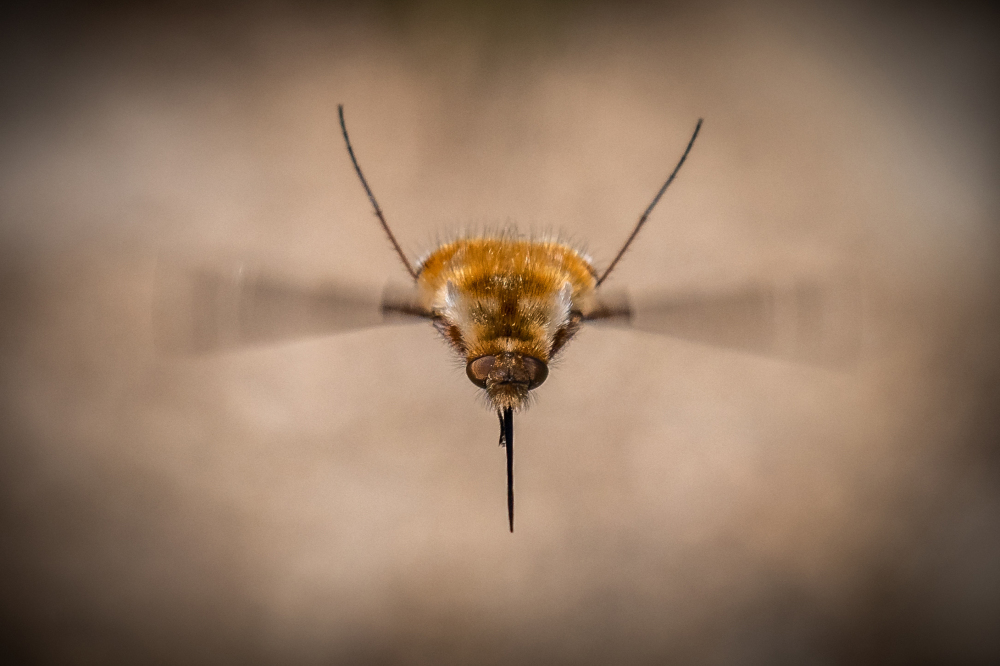You may have been seeing some scary-looking insects in your garden thanks to the warm spring we've had – bees with long spikes, scorpion-like beetles, supersized aphids and maggots with long tails.

What weird insects are you spotting in the garden?
But there's no need for alarm, says RHS principal entomologist Andrew Salisbury. "Insects are breeding faster now and the season seems to be a bit earlier this year," he explains. "But there's no need to be alarmed when you see one of the weirder-looking species, because they all contribute to a healthy ecosystem."
Here are five such insects, which may cause alarm – but shouldn't…
1. Bee fly (Bombylius major)
This looks like a bee, but has a long spike (proboscis) protruding at the front. It's not a stinger, though, it's just to help the bee fly extract pollen more easily. It's harmless to humans – it doesn't sting or bite, it just mimics bees.
Its larval stage is parasitic and the bee fly will dive-bomb solitary bee nests with its eggs, depositing them where there are solitary bees nesting. When the bee fly grub hatches, it feeds on the store that solitary bees use for their grubs and can eventually move on to killing the solitary bee grub itself.
"If you've got a good population of bee flies, you've probably got a really good population of the things they feed on, so solitary bees. It's a sign you have a healthy ecosystem if you see bee flies," says Salisbury.
2. Devil's coach horse beetle (Staphylinus olens)
This is a large black beetle about 2.5cm long, ground-living and can be confused with a small scorpion because it has short wing cases and can rear right up. It's a voracious predator, feeding on slugs, vine weevils and other garden pests after dark, moving fast and preferring to run along the ground rather than fly. When it lifts its rear end it has a gland it can stick out to give off an unpleasant odour.
You're likely to see it on a path, or if you lift up a log or stone in the garden. But don't pick it up as it has large jaws and could nip you, as well as giving off that pungent odour. However, it is a valuable garden predator.
3. Hummingbird hawk-moth (Macroglossum stellatarum)
This is a day-active moth which is more than 2.5cm long. It has a brown, white-spotted abdomen and orange hind wings, but in flight the colours blur.
As its name suggests, it behaves like a hummingbird and people often mistake it for one. It's a migratory moth, coming from southern Europe and north Africa, and is not expected to survive winter over here, but does arrive from early spring and can be found as far north as the Shetland Islands.
It will visit flowers and hover over the flower to feed, but its caterpillars rarely appear in Britain.
4. Large willow bark aphid (Tuberolachnus salignus)

This supersized aphid – related to greenfly and blackfly – is about half a centimetre in length and is often mistaken for a beetle or spider, but doesn't tend to wreak havoc on more vulnerable plants.
It generally only occurs in large numbers on willow trunks, and doesn't do much damage to the tree. The aphid has a sort of shark's fin shape on its back, but nobody knows what it's for. The aphids are very visible on the trunks of willow in spring. Its predators include parasitic wasps, birds and ladybird larvae.
5. Hoverfly (Eristalis tenax)

Also known as the drone fly, the hoverfly looks like a honeybee and is territorial. You'll often see the male hovering in the same place, trying to keep a territory and look for females.
Drone flies (rat-tailed maggots) are about 2cm long with a long tail, and feed in stagnant water full of organic matter. The rat-tail is used to stick out of the water to get oxygen.
You may find the maggots in a stagnant pond or a trough with leaves and water. Sometimes they will emerge in very wet compost heaps. The maggots are feeding on decomposing matter, so they are part of the ecosystem process, but do look pretty gross.

